
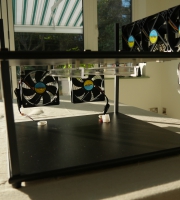
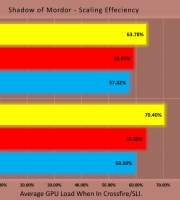
Our Average Joes are content with their purchases, but as 2012 dawned, each learned of a new standard of PCI Express, revision 3.0, which was to offer double the bandwidth of the present version and be readily adopted by, amongst others, our two old friends at green and red HQ, Nvidia and AMD in their eternal struggle for graphical glory. With both Joe’s planning to upgrade their video cards, they wondered if their motherboard’s would be able to fully exploit the potential of this coming and future generations.
Average Joe 2: Uh, Mr Intel, I just wanted to know I my motherboard will allow me to take full advantage of the new pci express 3.0 graphics cards Nvidia’s planning next year.
Mr Intel: My chipset’s specification is very clear 16 pci express lanes configurable as either 1 slot running at x16 or two running at 8, all revision 2.0.
Average Joe 2: oh, so no chance of a bios update to enable support for pci express 3.0.
Mr Intel: I state nothing that is not in my official specifications, though such support wouldn’t be possible with a BIOS update. Future PCI-E 3.0 cards will in theory function in your board since the standard is backwardly compatible but they will only run at the speed PCI-E 2.0 allows. I’ll be offering full PCI-E 3.0 support with my next sensational chipset and miraculous “Ivy Bridge” processors, which I refuse to talk about right now.
Average Joe 1: Mr Asus? I have just purchased this, it’s AMD’s new Radeon HD 7970, a PCI-Express 3.0 video card, will it run to it’s full potential in the board I acquired from you, that’s the P8-Z68-V Pro?
Mr Asus: No it won’t, in order to obtain full PCI-E 3.0 support you’ll need one of our “GEN 3”, like this one:
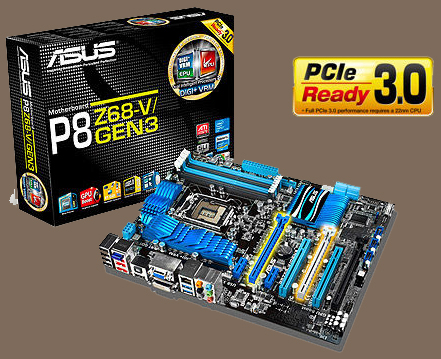
Average Joe 1: But that’s the board I have, at least, it looks identical.
Mr Asus: Not quite, see right there, above the first PCI-Express slot, those little chips are bridge chips known as “switching ICs”, they sit in between the CPU and your PCI Express slots and are required when you run multiple video cards, to allocate equal bandwidth to each. When I built your board, the only switches that were available supported PCI-Express 2.0, these new ones came out a few months later.
Average Joe 1: Really? So, any reason you didn’t wait and just release this one, wouldn’t it have been less confusing.
Mr Asus: Intel releases a chipset, I’m compelled to forge accompanying boards immediately, its what I do, I have many rivals doing the same, look at what Asrock and Gigabyte are upto these days. I have lots of other GEN 3 boards now if you’d like to see them.
Average Joe 1: No that’s ok, I’ll be off now.
Average Joe 2: Excuse me Mr Asus, I spoke to Mr. Intel about this and he said he’d only be supporting PCI Express 3.0 on his next chipset.
Mr. Asus: That’s sort of corrent, For PCI Express 3.0 to actually work, you will need one of his new “Ivy Bridge” CPU’s as well, the controller in the “Sandy Bridge” processors only supports 2.0. But look, you don’t have to wait for his chipset or any boards he might knock up, why not just get one of my Gen 3 boards now and be fully prepared for when the processors arrive, then if the chipset turns out to be a real hit, come back and buy another of my boards and transfer the processor over to that. Wait till you see the line up I have planned. There’s a workstation series, a P8 series, should please you that one, my Republic of Gamers line, the Sabretooth….ohhh I can’t wait.
A few months later, in April, our silicone sorcerer true to his word, conjured up another new chipset…
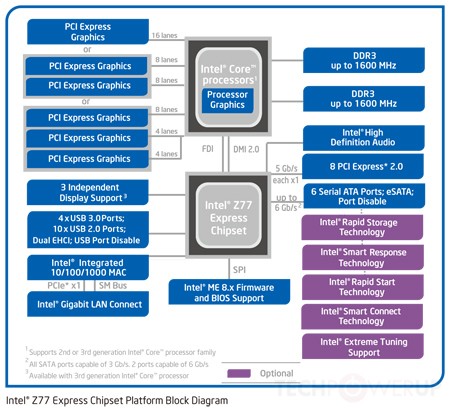
The third in little over a year to incorporate the same 1155 pin socket. Moreover, a novel brigade of processors materialise alongside it. Once again, externally they and their elders were physical dead ringers, though just as the “Westmere” had been the “Nehalem’s”” refined successor, so too were these chips destined to displace clan “Sandy Bridge”. Beneath each heat spreader resided over a billion of Intel’s revolutionary tri gate 3d transistors packed into four cores on a smaller die of 22nm, all representing a 20% reduction in energy consumption and a performance increase to match.
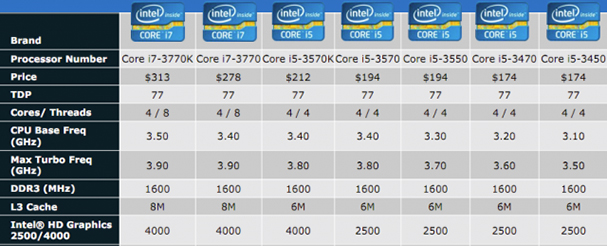
A markedly fleeter and more versatile integrated graphics chip was also present along with 4 native USB 3.0 ports. Improvements had been made to “Quick Sync”, a feature introduced in the Sandy Bridge era to greatly reduce video rendering and decoding times, DDR3 speeds of upto 1600mhz were officially supported and finally, as pledged, the Ivy Bridge’s built in PCI Express controller served up 16 lanes of third generation bandwidth bandwidth to any designated slot.
Our average Joes, perhaps a little blitzed in the brain as well as the pockets, do not wish to undergo the inconveniences of a full system overhaul. With both their builds proving stable and efficient, the option of enduring this minor setback seemed far more attractive. PCI Express 2.0 should surely be fast enough for now. All the same. The benefits the new Ivy Bridge CPUs appear to offer are tempting, the question was, were they compatible with the boards they had already invested in?
To their great relief, both Intel and Asus promptly compiled a BIOS update to allow Joe 1, Joe 2 and others whose motherboards harboured Intel’s earlier chipsets, the opportunity to revel in the enhancements an”Ivy Bridge” CPU granted….excluding PCI Express 3.0!